Themed collection FOCUS: Recent progress on electrocatalytic CO2 reduction

Heterojunction catalysts for CO2–HCOOX interconversion cycles
This review summarizes recent advances in heterojunction-type catalysts for CO2-HCOOX interconversion under different driving forces, focusing on rectifying effects at the interface and the potential for developing heterojunction-based catalysts for practical applications.

Mater. Chem. Front., 2024,8, 2300-2321
https://doi.org/10.1039/D4QM00160E
Coupling electrochemical CO2 reduction with value-added anodic oxidation reactions: progress and challenges
This review presents recent advances and future challenges of emerging and potential alternative anodic reactions with high energy-efficiency and value-added products in overall CO2 electrolysis.
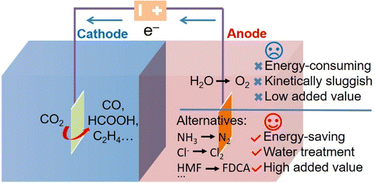
Mater. Chem. Front., 2024,8, 341-353
https://doi.org/10.1039/D3QM00625E
Recent advances in electrocatalytic reduction of ambient CO2 toward high-value feedstock
The effects of climate change have arisen due to greenhouse gases emitted into the atmosphere, and the finite supply of fossil fuels will eventually be unable to support the needs of the petrochemical industry.

Inorg. Chem. Front., 2023,10, 7095-7108
https://doi.org/10.1039/D3QI01522J
Application of MOF-derived materials as electrocatalysts for CO2 conversion
This review summarizes the four main synthesis strategies of MOF-derived materials, and the feasibility and challenges of MOF-derived materials in ECO2RR are discussed.

Mater. Chem. Front., 2023,7, 6107-6129
https://doi.org/10.1039/D3QM00835E
Electronic and geometric modulations of catalysts for electrochemical CO2 reduction reaction
Modulations of electronic structures of active sites and geometric structures of catalyst supports play important roles in electrocatalytic activity and selectivity for the carbon dioxide reduction reaction.

Mater. Chem. Front., 2023,7, 4723-4743
https://doi.org/10.1039/D3QM00364G
Unveiling the effects of ions in the electric double layer on the carbon dioxide reduction reaction
This paper reviews the recent advances in understanding the effects of cations and anions on determining the electrocatalytic mechanisms and performance of the electrochemical carbon dioxide reduction reaction.

Mater. Chem. Front., 2023,7, 2750-2763
https://doi.org/10.1039/D3QM00277B
All-alkynyl-protected coinage metal nanoclusters: from synthesis to electrocatalytic CO2 reduction applications
Alkynyl-protected metal nanoclusters possess unique advantages, and the recent progress on the controllable synthesis and CO2 electroreduction application is discussed, with some explicit examples to elaborate the structure-performance relationship.

Mater. Chem. Front., 2023,7, 1482-1495
https://doi.org/10.1039/D2QM01282K
Steady Cu+ species via magnesium and boron co-modification for enhanced CO2 electroreduction to C2+ products: an in situ Raman spectroscopic study
In situ Raman spectroscopy reveals that Mg and B synergistically stabilize Cu+ across a wide potential range on a Cu-based catalyst, facilitating the conversion of CO2 to C2+ products.

Inorg. Chem. Front., 2024,11, 4770-4779
https://doi.org/10.1039/D4QI00842A
Development of In–Cu binary oxide catalysts for hydrogenating CO2via thermocatalytic and electrocatalytic routes
Carbon dioxide (CO2) hydrogenation to obtain valuable chemicals and fuels via thermocatalysis or electrocatalysis is a promising and sustainable method for CO2 utilization.

Inorg. Chem. Front., 2024,11, 2319-2338
https://doi.org/10.1039/D3QI02499G
Boosting the catalytic performance of metalloporphyrin-based covalent organic frameworks via coordination engineering for CO2 and O2 reduction
Coordination engineering is an effective strategy for improving the performance of Por-COFs in catalyzing CO2 and O2 electroreduction. Our computations suggest that Co–N2O2 and Ni–N2S2 coordinated Por-COFs could be potential candidates.

Mater. Chem. Front., 2024,8, 1958-1970
https://doi.org/10.1039/D3QM01315D
A defective bismuth–indium catalyst promotes water dissociation for selective carbon dioxide electroreduction to HCOOH
A defective BiIn bimetallic catalyst derived from a P-doped BiIn pre-catalyst is developed, which enables CO2 conversion to HCOOH with high activity and selectivity.

Inorg. Chem. Front., 2024,11, 1703-1709
https://doi.org/10.1039/D4QI00053F
Robust imidazole-linked Ni-phthalocyanine-based covalent-organic framework for CO2 electroreduction in the full pH range
Ni-phthalocyanine-based covalent-organic framework linked by imidazole group exhibits brilliant stability and high activity of CO2 electroreduction reaction with over 90% CO Faradic efficiency in full pH range.

Mater. Chem. Front., 2024,8, 1611-1618
https://doi.org/10.1039/D3QM01190A
Molecular modification of planar four-coordinated cobalt active site for the electrochemical reduction of carbon dioxide: a density functional theory study
A systematic theoretical investigation on the carbon dioxide reduction reaction over ten single cobalt-containing compounds was performed to screen the excellent catalyst candidates from the thermodynamics perspective.

Inorg. Chem. Front., 2023,10, 7054-7063
https://doi.org/10.1039/D3QI01643A
FeNi3 nanoparticles for electrocatalytic synthesis of urea from carbon dioxide and nitrate
FeNi3 alloy is adopted for catalyzing nitrate and carbon dioxide reduction to produce urea at ambient conditions. The catalyst delivers a larger urea yield rate and faradaic efficiency in comparison with the counterparts.

Mater. Chem. Front., 2023,7, 4952-4960
https://doi.org/10.1039/D3QM00627A
Bifunctional metal-free porous polyimide networks for CO2 capture and conversion
Carbon dioxide (CO2) capture and conversion into valuable chemicals is a promising and sustainable way to mitigate the adverse effects of anthropogenic CO2 and climate change.

Mater. Chem. Front., 2023,7, 4473-4481
https://doi.org/10.1039/D3QM00639E
Tunable functional groups on MXene regulating the catalytic property of anchored cobalt phthalocyanine for electrochemical CO2 reduction
CoPc was anchored on an MXene support bearing terminal –F or –OH. The –OH can axially coordinate with Co forming Co–O coordination, through which the electronic states of the Co center were tuned realizing an efficient ECRR performance.

Inorg. Chem. Front., 2023,10, 5371-5378
https://doi.org/10.1039/D3QI01070H
Structural reconstruction of BiPbO2Br nanosheets for electrochemical CO2 reduction to formate
A Bi–Pb composite catalyst with heterogeneous interfaces obtained by electroreduction of BiPbO2Br nanosheets exhibits impressive performance for CO2 reduction to formate.

Mater. Chem. Front., 2023,7, 3382-3389
https://doi.org/10.1039/D3QM00262D
Bifunctional electroreduction catalysts of NiFe alloy on N-doped carbon toward industrial-level CO2 conversion powered by Zn–air batteries
A bifunctional electrocatalyst, comprising NiFe alloy on N-doped carbon, was prepared for an integrated electrochemical device capable of implementing CO2 conversion. This device is powered by a homemade Zn–air battery.

Inorg. Chem. Front., 2023,10, 4484-4495
https://doi.org/10.1039/D3QI00966A
Distance produces beauty? regulating the distance of Fe atomic pairs to enhance electrocatalytic CO2 reduction
Accurately controlling the distance between Fe atoms can enhance the electrocatalytic activity for carbon dioxide reduction and promote the C–C coupling process, thus promoting the production of ethanol.

Mater. Chem. Front., 2023,7, 3146-3155
https://doi.org/10.1039/D3QM00261F
Mechanistic insights into the electrochemical reduction of CO2 to CO on Ni(salphen) complexes
Ni(salphen) reduces CO2 to CO via a double reduction/protonation mechanism, and the active species binds to CO, only releasing stoichiometric amounts of CO upon exposure to air. This has been confirmed in both experimental and computational studies.

Inorg. Chem. Front., 2023,10, 4175-4189
https://doi.org/10.1039/D3QI00424D
A supported polymeric organic framework composed of dual electrocatalytically active sites for high-performance carbon dioxide electroreduction
We construct an organic–inorganic hybrid electrocatalyst by the template-directed in situ polymerization of porphyrin-based organic framework with dual catalytic sites on the CNT scaffold for high-performance CO2 electroreduction.
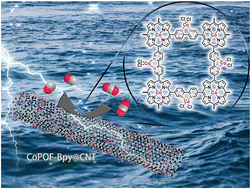
Inorg. Chem. Front., 2023,10, 3963-3973
https://doi.org/10.1039/D3QI00589E
Viologen linker as a strong electron-transfer mediator in the covalent organic framework to enhance electrocatalytic CO2 reduction
Viologen groups as a strong electron transfer mediator are inserted in Por(Co)-Vg-COF to improve the electronic conductivity and thus showed highly efficient electroreduction of CO2 in neutral/acidic/alkaline electrolytes.

Mater. Chem. Front., 2023,7, 2661-2670
https://doi.org/10.1039/D3QM00218G
Graphdiyne/copper sulfide heterostructure for active conversion of CO2 to formic acid
The synthesis of electrocatalysts with high selectivity, activity, and stability for the CO2 reduction reaction (CO2RR) is a promising and sustainable route to convert CO2 into value-added chemicals at room temperatures and pressures.

Mater. Chem. Front., 2023,7, 2620-2627
https://doi.org/10.1039/D3QM00245D
Enhancing CO2 electrolysis performance with various metal additives (Co, Fe, Ni, and Ru) – decorating the La(Sr)Fe(Mn)O3 cathode in solid oxide electrolysis cells
An enhanced CO2 electrolysis current density of 2.20 A cm−2 @ 1.5 V at 1123 K is achieved for LSFM electrodes using Fe catalyst rather than Ru, Ni, and Co catalysts.

Inorg. Chem. Front., 2023,10, 3536-3543
https://doi.org/10.1039/D3QI00379E
Tera-hertz (THz) catalysis on MXene for enhanced selectivity from CO2 to CO
Applying Natural Language Processing (NLP) to journals about catalytic reaction, we found a gap between photocatalysts and thermal catalysts, where Tera-Hertz (THz) catalysis is located; therefore, we have investigated THz catalysis in this work.

Inorg. Chem. Front., 2023,10, 2903-2910
https://doi.org/10.1039/D2QI02476D
Electroreduction of CO2 to syngas with controllable H2/CO ratios in a wide potential range over Ni–N co-doped ultrathin carbon nanosheets
Electrocatalytic reduction of CO2 to syngas with tunable proportions in a wide potential range over Ni–N co-doped ultrathin carbon nanosheets.

Inorg. Chem. Front., 2023,10, 2414-2422
https://doi.org/10.1039/D3QI00108C
Cu–Ni alloy decorating N-doped carbon nanosheets toward high-performance electrocatalysis of mildly acidic CO2 reduction
The nitrogen-doped “willow leaf” shaped carbon nanosheets modified with Cu-Ni alloy shows excellent electrocatalytic activity for reducing CO2 to CO under mildly acidic media.

Inorg. Chem. Front., 2023,10, 2276-2284
https://doi.org/10.1039/D3QI00207A
Pyridyl-containing graphdiyne stabilizes sub-2 nm ultrasmall copper nanoclusters for the electrochemical reduction of CO2
Pyridyl-containing graphdiyne provides well-defined sites for stabilizing sub-2 nm copper nanoclusters, which show an optimum CH4 faradaic efficiency of 58% in the electrochemical CO2 reduction reaction.

Inorg. Chem. Front., 2023,10, 2189-2196
https://doi.org/10.1039/D2QI02671F
Nano-polyaniline enables highly efficient electrocatalytic reduction of CO2 to methanol in supporting electrolyte-free media and the detection of free-radical signals
Metals and metal oxides are widely used as catalysts for the electrochemical reduction of CO2.
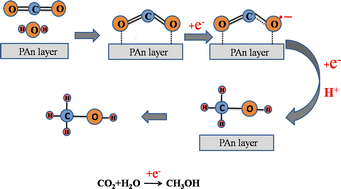
Mater. Chem. Front., 2023,7, 1385-1394
https://doi.org/10.1039/D2QM01119K
Steering CO2 electroreduction selectivity towards CH4 and C2H4 on a tannic acid-modified Cu electrode
The selectivity of C2H4 and CH4 in CO2 electroreduction can be modulated on a Cu electrode by tannic acid modification, which jointly promotes H2O dissociation and stabilizes the intermediate.

Mater. Chem. Front., 2023,7, 1395-1402
https://doi.org/10.1039/D2QM01259F
Electrochemical conversion of CO2 into HCOO− in a synergistic manner by a nanocomposite of Zn2SnO4/ZnO
A Zn2SnO4/ZnO nanocomposite is developed for effectively catalyzing the reduction of CO2 to formic acid, owning to the potential capacity to regulate electronic structure by interfacial interaction.

Inorg. Chem. Front., 2023,10, 1818-1825
https://doi.org/10.1039/D2QI02762C
Atomically dispersed copper catalysts for highly selective CO2 reduction
Support substrates play important roles in the catalysis process.

Inorg. Chem. Front., 2023,10, 675-681
https://doi.org/10.1039/D2QI02288E
In situ surface/interface generation on Cu2O nanostructures toward enhanced electrocatalytic CO2 reduction to ethylene using operando spectroscopy
Electrocatalytic CO2 reduction reactions (CO2RRs), an efficient method of converting carbon dioxide into valuable fuels and chemicals, are attractive as well as challenging.
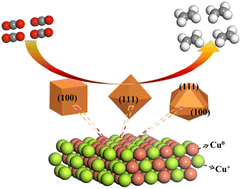
Inorg. Chem. Front., 2023,10, 240-249
https://doi.org/10.1039/D2QI01977A
Metal–oxide heterointerface synergistic effects of copper–zinc systems for highly selective CO2-to-CH4 electrochemical conversion
Highly efficient CO2 electroreduction to methane (CH4) is achieved over a precisely controlled Cu–ZnO heterointerface system, delivering a superior activity with a faradaic efficiency of up to 72.4% at −0.7 V vs. RHE.

Inorg. Chem. Front., 2023,10, 168-173
https://doi.org/10.1039/D2QI02051C
Multivariate indium–organic frameworks for highly efficient carbon dioxide capture and electrocatalytic conversion
A series of trinuclear indium–organic frameworks was synthesized and this work demonstrates that bimetallic engineering is a promising strategy for efficient CO2 capture and electrocatalytic CO2 conversion.

Inorg. Chem. Front., 2023,10, 158-167
https://doi.org/10.1039/D2QI02020C
Highly efficient electrochemical CO2 reduction over crystalline–amorphous In2O3–CeOx heterostructures
The crystalline–amorphous In2O3–CeOx heterostructure was fabricated for highly efficient electroreduction of CO2 to formate at a large potential window and the maximum faradaic efficiency reached 94.8%.

Inorg. Chem. Front., 2022,9, 5926-5931
https://doi.org/10.1039/D2QI01646J
Covalent organic frameworks based on tetraphenyl-p-phenylenediamine and metalloporphyrin for electrochemical conversion of CO2 to CO
The as-prepared TPPDA-CoPor-COF shows high CO faradic efficiencies of 87–90% from −0.6 to −0.9 V vs. RHE, and the largest CO partial current density of TPPDA-CoPor-COF exceeds most of reported COF-based electrocatalysts.

Inorg. Chem. Front., 2022,9, 3217-3223
https://doi.org/10.1039/D2QI00336H
In situ reconstruction of vegetable sponge-like Bi2O3 for efficient CO2 electroreduction to formate
The vegetable sponge-like Bi2O3 was prepared using a microwave-ultrasonic strategy, with in situ reconstruction boosting the CO2RR performance.

Mater. Chem. Front., 2022,6, 1091-1097
https://doi.org/10.1039/D1QM01557E
In/ZnO@C hollow nanocubes for efficient electrochemical reduction of CO2 to formate and rechargeable Zn–CO2 batteries
In/ZnO@C hollow nanocubes derived from In(OH)3-doped Zn-MOFs were developed for the electrochemical reduction of CO2 to formate and rechargeable aqueous Zn–CO2 batteries.

Mater. Chem. Front., 2021,5, 6618-6627
https://doi.org/10.1039/D1QM00825K
Electrochemical fixation of CO2 over a Mo plate to prepare a Mo2C film for electrocatalytic hydrogen evolution
Electrochemical reduction of CO2 over a metal substrate integrates fixation of CO2 and surface carbonization of the metal to functional films.
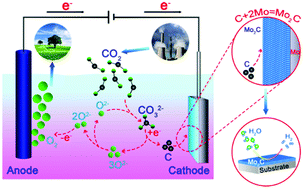
Mater. Chem. Front., 2021,5, 4963-4969
https://doi.org/10.1039/D1QM00443C
Bromine anion mediated epitaxial growth of core–shell Pd@Ag towards efficient electrochemical CO2 reduction
A Br− mediated epitaxy growth is proposed to fabricate core–shelled Pd@Ag electrocatalysts highly active for CO2 reduction.

Mater. Chem. Front., 2021,5, 4327-4333
https://doi.org/10.1039/D1QM00169H
Nitrogen dopant induced highly selective CO2 reduction over lotus-leaf shaped ZnO nanorods
In this work, N-doped ZnO nanorods were prepared via a simple plasma treatment. The resulting catalyst showed high electroreduction activity of CO2 at a low applied potential, achieving a maximum faradaic efficiency of 76 ± 4% and 30 h stability.

Mater. Chem. Front., 2021,5, 4225-4230
https://doi.org/10.1039/D1QM00344E
Boosting CO2 electroreduction to CO with abundant nickel single atom active sites
A facile route for a single-atom Ni catalyst (Ni–SAs–NC) with dense Ni–N4 active sites is reported; the as-prepared Ni–SAs–N4C shows a 98% faradaic efficiency (FE) at −0.65 V for CO generation.

Inorg. Chem. Front., 2021,8, 2542-2548
https://doi.org/10.1039/D1QI00126D
Three-dimensional porous copper-decorated bismuth-based nanofoam for boosting the electrochemical reduction of CO2 to formate
A Cu-decorated Bi/Bi2O3 nanofoam with a 3D porous network structure was assembled, which exhibits excellent electrocatalytic performance toward electrocatalytic CO2 reduction owing to the optimized morphology and electronic structure.

Inorg. Chem. Front., 2021,8, 2461-2467
https://doi.org/10.1039/D1QI00065A
Efficient and steady production of 1 : 2 syngas (CO/H2) by simultaneous electrochemical reduction of CO2 and H2O
A guest–host pyrolysis strategy is used to synthesize a Co–C/Nx-based single-site catalyst, featuring excellent electrocatalytic performance for syngas production by electrochemical reduction of CO2 and H2O (FE nearly 100%, formation rate 1.08 mol g−1 h−1 at 1.0 V vs. RHE).
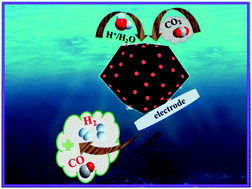
Inorg. Chem. Front., 2021,8, 1695-1701
https://doi.org/10.1039/D0QI01351J
About this collection
Materials Chemistry Frontiers and Inorganic Chemistry Frontiers are delighted to introduce you the following collection of articles on “electrocatalytic CO2 reduction”. Articles featured in our focus collections are handpicked by Editors. We hope you find them enjoyable to read. Access is free till 25 August.